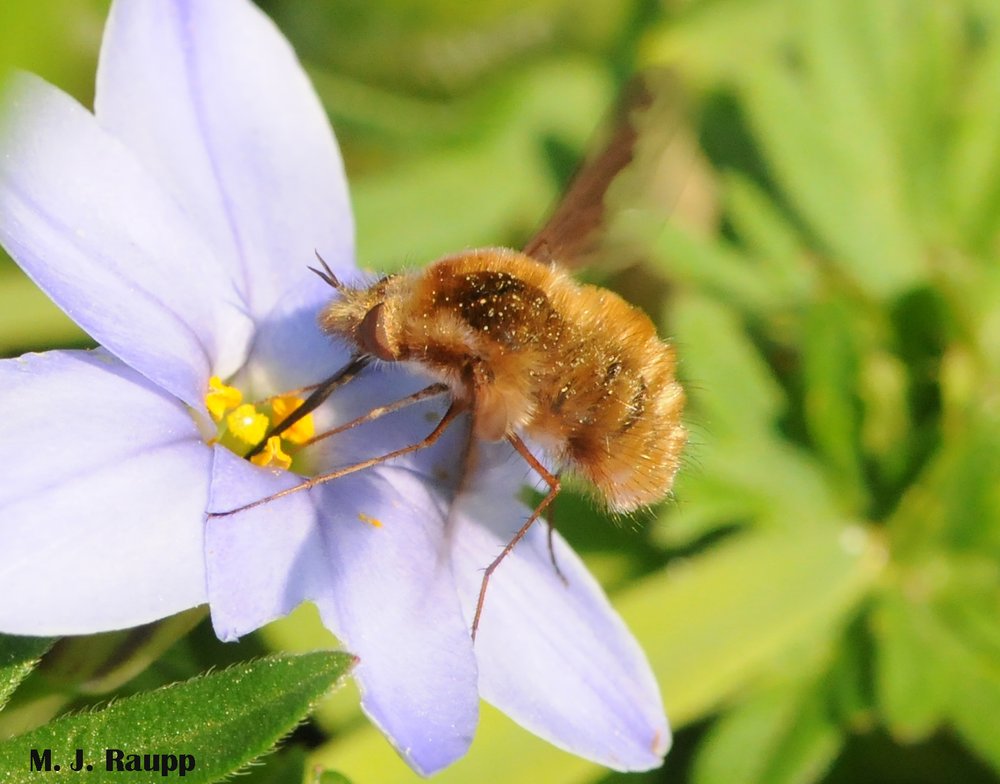Danger afoot for ground nesting bees: Look out for bee flies, Bombyliidae

Bee flies like this Greater Bee Fly frequent meadows bustling with blossoms and are often mistakenly identified as bees.

Distinct patches of black on the wings of Chrysanthrax cypris make it easy to identify this pollinator in the meadow.
Last week we visited a feral colony of honey bees energetically engaged in their business of pollination in downtown Greenville, South Carolina. This week we jump some 500 miles north to the banks of the mighty Potomac River near Antietam National Battlefield. Along the alluvial banks of the river, galleries of ground nesting bees abound. And on an 80-degree day last week, fleets of busy pollinators darted among dandelions and hovered near patches of Dutchman’s breeches and Virginia bluebells. One particularly frenetic insect appeared to be some kind of furry bee with a wickedly long tongue that probed the depths of florets. Closer inspection revealed the fancy flier’s flight gear included one pair of wings not two, a sure sign that this was a fly and not a true bee. The close resemblance of these hairy flies to pollinators such as honey bees and bumble bees has earned them the name bee fly. Bee flies have a remarkably long mouthpart called a proboscis that is modified to reach deep into flowers to sip the carbohydrate rich nectar, which is an important source of energy for these hyperactive fliers. Although they do not deliberately collect pollen as a source of food for themselves or their young as do bees, their hairy coat traps pollen and provides convenient transport of pollen from one plant to another.
On a chilly spring morning a bee fly performs a pre-flight warm-up by rapidly fluttering its wings. Bee flies require huge amounts of carbohydrates, which they obtain from nectar, to power flight. Watch as the Greater Bee Fly, Bombylius major, gathers nectar from a dandelion with its ridiculously long proboscis. Busy mouthparts dance across the blossom. Bee fly cousins with tongues as long as their bodies provide similar pollination services to beautiful wildflowers in the Mojave Desert.

Pretty Anthrax georgicus devours larvae of ground dwelling tiger beetles as they develop in their earthen galleries.
The fact that bee flies are common around flowers during this season of high bee activity is more than just a coincidence. Bee flies have a seamier side that often proves deadly for other species of insects. When solitary ground nesting bees such as halictids, colletids, and andrenids visit a flower and get a full load of nectar and pollen, they head back to their nest to provision it with food for their young. The wily and agile bee fly follows a bee back to its nest and deposits an egg in or near the burrow of the bee. After hatching, the fly larva enters the gallery of the bee. Some species of bee flies first consume provisions left behind by the solitary bee before turning their attention to the developing baby bees. They attach to the skin of the larval bee and suck its blood, which is the source of nutrients for the developing larva of the bee fly. A fascinating account by the great naturalist Jean-Henri Fabre (1823 – 1915) describes the attack of a bee fly larva in the genus Anthrax (described below as the worm and nursling) on a leafcutter bee larva in the genus Chalicodoma (called the nurse). “The worm is fixed by its sucker to any convenient part of the nurse, plump and fat as butter. It is ready to break off its kiss suddenly, should anything disquiet it, and to resume it as easily when tranquility is restored. No Lamb enjoys greater liberty with its mother’s teat. After three or four days of this contact of the nurse and nursling, the former, at first replete and endowed with the glossy skin that is a sign of health, begins to assume a withered aspect. Her sides fall in, her fresh color fades, her skin becomes covered with little folds and gives evidence of an appreciable shrinking in this breast which, instead of milk, yields fat and blood. A week is hardly past before the progress of the exhaustion becomes startlingly rapid. The nurse is flabby and wrinkled, as though borne down by her own weight, like a very slack object. If I move her from her place, she flops and sprawls like a half-filled water bottle over the new supporting plane. But the Anthrax’ kiss goes on emptying her: soon she is but a sort of shriveled lard bag, decreasing from hour to hour, from which the sucker draws a few last oily drains. At length, between the twelfth and the fifteenth day, all that remains of the larva of the mason bee is a white granule, hardly as large as a pin’s head.” Yikes!
Bee flies are a large diverse group known to attack and kill caterpillars, eggs of grasshoppers, and larvae of beetles, as well as baby bees. So, bees and other insects beware, bee flies are on the wing.
Acknowledgements
The Master Naturalist Program of the University of Maryland and eagle-eyed Dr. Shrewsbury provided the inspiration for this episode, a version of which was published pre-pandemic in 2018. The wonderful references “Insects: Their natural history and diversity” by Stephen Marshall, “The Life of the Fly” by J. Henri Fabre and the Maryland Biodiversity Project were used as references for this episode.
This post appeared first on Bug of the Week